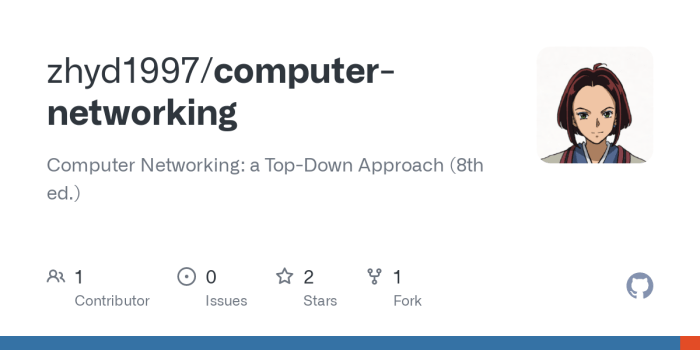Computer networking a top-down approach 8th edition answers – Embark on a comprehensive exploration of computer networking with our in-depth analysis of “Computer Networking: A Top-Down Approach, 8th Edition.” This authoritative guide unravels the complexities of network fundamentals, protocols, media, devices, security, and management, providing a solid foundation for understanding and navigating the ever-evolving digital landscape.
Through a top-down approach, we delve into the intricacies of network design, implementation, and management, empowering you with the knowledge and skills to excel in the field of computer networking.
Introduction to Computer Networking

Computer networking involves connecting computers and devices to share data and resources. Key components include:
- Nodes: Endpoints (e.g., computers, printers)
- Links: Communication channels (e.g., cables, wireless)
- Protocols: Rules for data exchange
The OSI model is a conceptual framework for understanding network communication, consisting of seven layers:
- Physical
- Data Link
- Network
- Transport
- Session
- Presentation
- Application
Network topologies describe how nodes are connected:
- Bus: Nodes share a common transmission medium
- Star: Nodes connect to a central hub
- Ring: Nodes form a closed loop
- Mesh: Nodes connect directly to multiple other nodes
Network Protocols
The TCP/IP protocol suite is a widely used set of protocols for network communication:
- TCP (Transmission Control Protocol): Provides reliable, connection-oriented data transmission
- IP (Internet Protocol): Provides addressing and routing for data packets
Other common network protocols include:
- UDP (User Datagram Protocol): Provides unreliable, connectionless data transmission
- DNS (Domain Name System): Translates domain names into IP addresses
- DHCP (Dynamic Host Configuration Protocol): Automatically assigns IP addresses to devices
Network Media: Computer Networking A Top-down Approach 8th Edition Answers

Network media transmit data between devices:
Copper Cables
Advantages:
- Low cost
- Easy to install
Disadvantages:
- Limited bandwidth
- Susceptible to interference
Fiber Optic Cables
Advantages:
- High bandwidth
- Low latency
Disadvantages:
- Expensive
- Difficult to install
Wireless Media
Advantages:
- Mobility
- Easy to deploy
Disadvantages:
- Limited range
- Susceptible to interference
Network Devices
Network devices connect and manage network traffic:
Routers, Computer networking a top-down approach 8th edition answers
Forward packets between different networks based on IP addresses
Switches
Connect devices within a network and forward packets based on MAC addresses
Hubs
Connect multiple devices and broadcast packets to all devices on the network
Network Security

Network security protects networks from unauthorized access and threats:
Network Security Threats
- Malware
- Hacking
- Phishing
Network Security Measures
- Firewalls
- Intrusion detection systems
- Encryption
Network Management
Network management involves monitoring and controlling networks to ensure performance and security:
Network Management Tasks
- Performance monitoring
- Fault detection
- Configuration management
Network Management Tools
- Network management systems (NMS)
- Protocol analyzers
- Packet sniffers
Top FAQs
What is the OSI model and its significance in computer networking?
The OSI (Open Systems Interconnection) model is a conceptual framework that divides network communication into seven layers. Each layer performs specific functions, allowing devices from different vendors to communicate seamlessly. It provides a common language for network designers and engineers, facilitating interoperability and troubleshooting.
How does TCP/IP differ from UDP in network communication?
TCP (Transmission Control Protocol) and UDP (User Datagram Protocol) are two fundamental transport layer protocols in the TCP/IP suite. TCP provides reliable, connection-oriented communication, ensuring data delivery and error correction. UDP, on the other hand, is a connectionless protocol that prioritizes speed and efficiency, making it suitable for applications like streaming media and online gaming.
What are the key network security threats and how can they be mitigated?
Network security threats include malware, phishing attacks, denial-of-service attacks, and unauthorized access. To mitigate these threats, organizations implement a combination of security measures, such as firewalls, intrusion detection systems, encryption, and network segmentation. Regular security audits and updates are also crucial for maintaining a secure network.